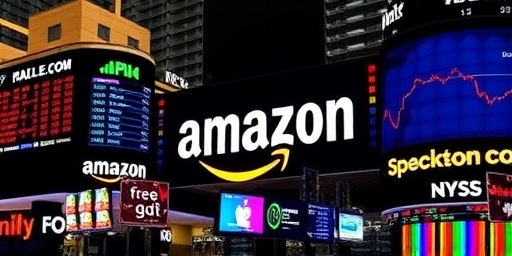The S&P 500 and Nasdaq kicked off November with impressive gains, climbing over 1.5% and 2.2% respectively in the first trading sessions, as investor enthusiasm for artificial intelligence investments reignited the stock market. Leading the charge was Amazon, whose shares soared to a fresh all-time high of $205.45, buoyed by reports of accelerated AI infrastructure spending across Big Tech.
This surge marks a continuation of the tech-driven momentum that has defined 2023, with the Nasdaq now up nearly 40% year-to-date. Market analysts attribute the optimism to corporate commitments to AI, including massive data center expansions and cloud computing advancements, signaling a robust economic outlook despite lingering inflation concerns.
Trading volume spiked to 12.5 billion shares on Monday, the highest in weeks, as institutional investors piled into AI-related stocks. The S&P 500‘s technology sector alone accounted for 65% of the index’s gains, underscoring the pivotal role of AI investment in shaping stock market dynamics.
Amazon’s AI Push Catapults Shares to New Peaks
Amazon’s ascent to record highs wasn’t just a flash in the pan; it reflected deeper strategic moves in the AI arena. The e-commerce giant reported in its latest earnings call that AWS, its cloud computing arm, saw a 19% revenue jump in the third quarter, largely driven by demand for AI training models and generative tools. CEO Andy Jassy emphasized during the call, “We’re investing billions in AI capabilities because we see it transforming every aspect of our business, from logistics to customer service.”
Shares of Amazon rose 4.1% on Tuesday, adding over $50 billion to its market capitalization in a single day. This performance outpaced peers like Microsoft and Google, which also benefited from AI hype but lagged slightly behind. Analysts from Goldman Sachs noted that Amazon’s diversified AI exposure—spanning retail personalization algorithms to supply chain optimizations—positions it uniquely in the stock market landscape.
Further fueling the rally, Amazon announced partnerships with AI startups, including a $4 billion investment in Anthropic, aimed at integrating advanced language models into its ecosystem. This move not only boosted investor confidence but also highlighted the interconnectedness of AI investment across the tech ecosystem. By midday Wednesday, Amazon’s stock had stabilized at $204.20, with trading options volume surging 150% as speculators bet on continued upside.
The company’s focus on sustainable AI development also drew praise. Amazon committed to powering its AI data centers with 100% renewable energy by 2025, addressing environmental concerns that have plagued the sector. This ESG angle resonated with institutional investors, contributing to the stock’s resilience amid broader market volatility.
AI Investment Frenzy Ignites Broader Nasdaq Gains
Beyond Amazon, the Nasdaq’s rally was a testament to widespread AI investment fervor. Semiconductor giants like Nvidia and AMD saw shares climb 3.5% and 2.8%, respectively, as demand for AI chips showed no signs of abating. Nvidia’s CEO Jensen Huang recently stated in an interview, “The AI revolution is just beginning, and our GPUs are at the heart of it.” This sentiment echoed through the market, with AI-related ETFs like the Global X Robotics & Artificial Intelligence ETF (BOTZ) posting a 2.7% gain.
The S&P 500, while more diversified, couldn’t escape the AI wave. Information technology stocks within the index rose 2.3%, pulling the overall benchmark higher. Key contributors included Apple, which unveiled new AI features for its iOS ecosystem, and Meta Platforms, reporting increased ad revenues from AI-optimized targeting.
Market data from Bloomberg indicates that AI investment pledges by S&P 500 companies have exceeded $200 billion for 2023, a 50% increase from the previous year. This capital influx is expected to drive innovation in sectors like healthcare and finance, where AI applications are proliferating. For instance, JPMorgan Chase announced a $1 billion AI fund to enhance fraud detection and trading algorithms, indirectly supporting the stock market’s upward trajectory.
However, not all sectors shared in the joy. Traditional industries like energy and utilities dipped 0.5%, as investors rotated funds into high-growth tech plays. The Nasdaq’s tech-heavy composition amplified these shifts, with the index’s volatility index (VIX) dropping to 16.2, its lowest in months, signaling reduced fear in the stock market.
- Nasdaq Composite: +2.2% (closing at 14,850 points)
- S&P 500: +1.5% (closing at 4,650 points)
- AI Sector ETF Performance: +3.1% average
- Trading Volume: 12.5 billion shares, up 20% week-over-week
These figures paint a picture of a market energized by AI prospects, but experts caution that over-reliance on a few mega-caps could introduce risks if growth expectations falter.
S&P 500’s Diversified Rally Signals Economic Resilience
While AI dominated headlines, the S&P 500’s gains revealed a more balanced recovery across sectors. Consumer discretionary stocks, buoyed by Amazon’s performance, advanced 1.8%, with retailers like Walmart and Target also posting modest increases on expectations of holiday AI-driven sales boosts. Financials edged up 0.9%, as banks anticipated benefits from AI-enhanced lending models.
Federal Reserve Chair Jerome Powell’s recent comments on moderating interest rates added to the positive vibe. In a speech last week, Powell noted, “Technological advancements like AI could enhance productivity growth, helping to tame inflation without derailing the economy.” This dovish tone eased fears of aggressive rate hikes, allowing the stock market to breathe easier.
Year-to-date, the S&P 500 has returned 22%, outperforming global peers like the FTSE 100 (up 5%) and Nikkei 225 (up 18%). This U.S. exceptionalism is largely credited to AI investment leadership, with American firms capturing 70% of global AI patents filed in 2023, according to a PwC report.
Retail investor participation hit record levels, with apps like Robinhood reporting a 30% uptick in AI stock trades. Social media buzz around Amazon and Nvidia further amplified the rally, creating a feedback loop of optimism. Yet, underlying economic data remains mixed: October’s non-farm payrolls added 150,000 jobs, below expectations, but unemployment held steady at 3.9%.
The S&P 500’s equal-weight index, which reduces mega-cap influence, rose 1.1%, suggesting the rally isn’t solely tech-dependent. This breadth could provide a buffer against potential AI hype corrections.
Market Analysts Predict Sustained AI-Driven Momentum
Wall Street heavyweights are bullish on the trajectory. JPMorgan’s Dubravko Lakos, head of U.S. equity strategy, forecasted in a note that “AI investment will propel the S&P 500 toward 5,000 by year-end, with Nasdaq potentially testing 16,000.” He cited robust corporate balance sheets and declining borrowing costs as enablers.
Conversely, some voices urge caution. BlackRock’s Rick Rieder warned of valuation bubbles, pointing out that Amazon’s forward P/E ratio now stands at 45, compared to the S&P 500 average of 20. “While AI is transformative, investors must differentiate between genuine innovation and speculative froth,” Rieder said in a CNBC interview.
Global ripple effects are emerging too. European indices like the DAX gained 1.2% on AI spillover optimism, while Asian markets, led by Taiwan’s TSMC (a key AI chip supplier), rose 1.8%. This interconnectedness amplifies the U.S. stock market’s influence worldwide.
Regulatory scrutiny adds another layer. The FTC’s ongoing antitrust probe into Big Tech AI dominance could impact mergers, but so far, it hasn’t dampened enthusiasm. In fact, Amazon’s lobbying efforts for AI-friendly policies have positioned it favorably.
- Monitor upcoming earnings: Amazon’s Q4 report in January could solidify trends.
- Watch Fed decisions: December’s rate meeting may influence borrowing for AI projects.
- Track geopolitical risks: U.S.-China tech tensions could disrupt supply chains.
Overall, analysts see AI as a multi-year tailwind, with projections for $1 trillion in annual AI spending by 2030.
Future Outlook: AI’s Role in Shaping Stock Market Horizons
Looking ahead, the stock market’s AI investment saga is far from over. With conferences like CES 2024 on the horizon, expect announcements of new AI hardware and software that could extend the rally into the new year. Amazon’s planned expansions in quantum computing-AI hybrids may unlock efficiencies in logistics, potentially adding billions to its bottom line.
For the S&P 500 and Nasdaq, sustaining momentum will hinge on real-world AI adoption. Pilot programs in autonomous vehicles and personalized medicine are showing promise, which could broaden the rally beyond tech. Investors are eyeing small-cap AI plays, like Palantir and C3.ai, which surged 5% and 4.2% respectively this week.
Potential headwinds include energy constraints for data centers and talent shortages in AI engineering. Yet, initiatives like the CHIPS Act, allocating $52 billion for U.S. semiconductor production, aim to mitigate these. As one venture capitalist put it, “AI isn’t just an investment theme; it’s the new industrial revolution.”
In this environment, diversified portfolios incorporating AI exposure stand to benefit most. The November surge serves as a reminder that in the stock market, innovation often trumps uncertainty, paving the way for prolonged optimism in the S&P 500, Nasdaq, and beyond.









